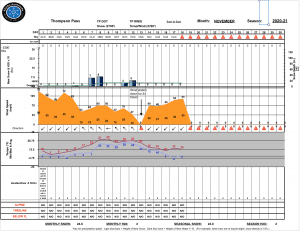Valdez
Above 4,000ftConsiderable
2,000 to 4,000ftConsiderable
Below 2,000ftLow
Degrees of Avalanche Danger
Avalanche Problems
Problem 1
We are at the tail end of a major storm that has deposited over 4″ of water to Valdez since 11/30. This translates to over 3 feet of snow for some places that were above the freezing line throughout the storm, above ~3000′. We are still within 24 hours of this event, the upper section of the snowpack will need time to adjust to this new snow. Human triggered storm snow avalanches will remain likely 12/3. Avoid slopes steeper than 35°, terrain traps and convex terrain features.
Likelihood:
- Almost Certain
- Very Likely
- Likely
- Possible
- Unlikely
Size:
- Historic
- Very Large
- Large
- Small
Trend
- Increasing
- Steady
- Decreasing
Problem 2
Weak Basal facets exist at the ground which have shown propagation energy in stability tests as recent as 11/30. These layers have been put to the test with the latest storm, and there may be areas that are still hanginging on by their fingernails. It is possible that a person or snowmachine could tip the balance and create very large destructive avalanches that would include the entire winters snowpack. Avoid large avalanche slopes and unsupported terrain.
Likelihood:
- Almost Certain
- Very Likely
- Likely
- Possible
- Unlikely
Size:
- Historic
- Very Large
- Large
- Small
Trend
- Increasing
- Steady
- Decreasing
Avalanche Activity
11/15: Natural avalanche observed in Loveland Basin on a South aspect, down the ridge from Tones Temple. This slide was triggered by recent NE wind loading and failed at the ground. SS-N-R1-D2-G
11/16: Natural avalanche observed on Billy Mitchell “Cry babys shoulder”. Released from~3500′ with a crown length of ~200 meters, North aspect. This slide was triggered by recent NE wind cross loading the slope. SS-N-R2-D2-U
11/29: Natural avalanche observed on Billy Mitchell Cry babys shoulder, similar elevation as 11/16 slide but originated a couple hundred meters further west. Released from ~4000′ with a crown length of ~ 200 meters, North aspect, ~ 37°, failed at the ground. HS-N-R2-D2.5-G

11/30- Natural avalanche observed on 40.5 mile peak just to the South of the Shovel. West aspect, ~4500′, crown ~200′ wide, poor light prevented further observation. SS-N-R1-D2-U.
12/2- DOT reported a natural D2.5-3 avalanche that hit the Lowe river at Snowslide Gulch.
Weather
12/3- The latest storm that has affected our area the last 72 hours is exiting. Precipitation is forecasted to taper off with falling temperatures.
The Thompson Pass Mountain Forecast covers the mountains (above
1000 ft) surrounding Keystone Canyon through Thompson Pass to
Worthington Glacier.
This forecast is for use in snow safety activities and emergency
management.
Today Tonight
Temp at 1000` 34 F 19 F
Temp at 3000` 20 F 18 F
Chance of precip 80% 50%
Precip amount
(above 1000 FT) 0.07 in 0.03 in
Snow amount
(above 1000 FT) 0-1 in trace
Snow level sea level sea level
Wind 3000` ridges SE 6-13 mph E 7-15 mph
Remarks...None.
| Date: 12/3 | 24 hr snow (inches) | HN24W (snow water equivalent inches) | High Temp (F) | Low Temp (F) | Weekly SWE Inches (Monday-Sunday) | December snowfall | Season snowfall | HS (snowpack depth inches) |
| Valdez | 0 | .91 | 36 | 29 | 3.71 | 5 | 48 | 23 |
| Thompson Pass | N/O | N/O | 32 | 20 | N/O | N/O | N/O | N/O |
| 46 Mile | 0 | .91 | 38 | 31 | 2.84 | 9 | 38 | 14 |
Thompson Pass weather history 20/21. Click on links below the images to see full size view

Announcements
The avalanche hazard is Considerable at mid and upper elevations. Human triggered avalanches are likely and natural avalanches are possible. We are within 24 hours of a major storm that has deposited over 30 ” of new snow since the evening of 11/30 at the Nick’s snotel at 4500′ feet. Allow the snowpack time to adjust to this added weight. Conservative terrain choices will be critical 12/3. The hazard will be decreasing as the storm exits, temperatures fall and precipitation ends.
At Low elevations the avalanche hazard is low, a rain soaked snowpack has refrozen and gained strength.
For more information click the (+full forecast) button below.
Your observations are valuable! If you have been out recreating in the mountains leave an observation.

